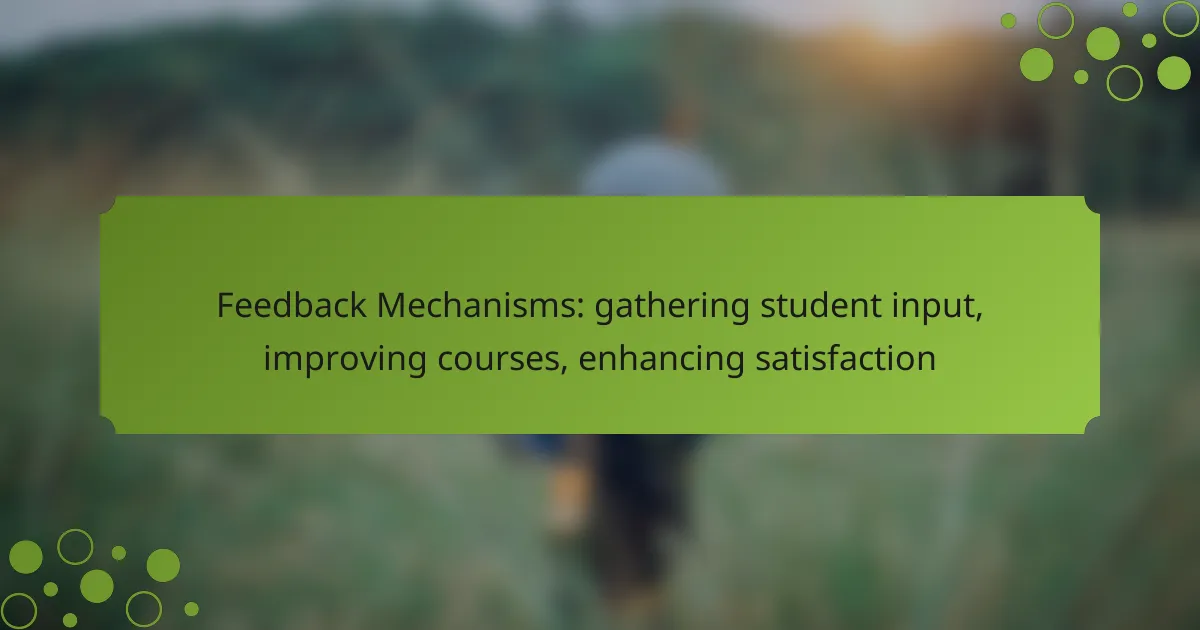
Feedback mechanisms play a crucial role in enhancing online courses by systematically collecting student input to inform necessary adjustments. By integrating student suggestions, educators can tailor their content and teaching methods, ultimately improving the learning experience and increasing overall satisfaction.

How can feedback mechanisms improve online courses?
Feedback mechanisms can significantly enhance online courses by systematically gathering student input, which informs course adjustments and improves overall learning experiences. By actively incorporating student suggestions, educators can tailor content and delivery methods to better meet learner needs.
Enhanced course content
Gathering feedback allows instructors to refine course materials based on student preferences and challenges. For instance, if students indicate that certain topics are unclear, educators can provide additional resources or modify lesson plans to clarify those areas. Regularly updating content based on feedback ensures that courses remain relevant and engaging.
Additionally, incorporating multimedia elements, such as videos or interactive quizzes, can be guided by student input. This responsiveness can lead to a richer learning environment that caters to diverse learning styles.
Increased student engagement
When students see their feedback being implemented, they are more likely to feel valued and engaged in the learning process. Engaging students through surveys or discussion forums not only provides insights but also fosters a sense of community. This connection can enhance motivation and participation in course activities.
To maximize engagement, consider using varied feedback methods, such as anonymous polls or open-ended questions, which can yield more honest and constructive responses. Regularly scheduled feedback sessions can also keep students involved and invested in their learning journey.
Higher satisfaction rates
Implementing effective feedback mechanisms can lead to higher student satisfaction rates. When learners feel that their voices are heard and their concerns addressed, they are more likely to report positive experiences. This can be reflected in course evaluations and retention rates.
To further boost satisfaction, ensure that feedback is acted upon promptly and transparently. Communicating changes made in response to student input can reinforce trust and encourage ongoing participation in feedback processes. Aim for continuous improvement to create a cycle of satisfaction and engagement.

What types of feedback mechanisms are effective?
Effective feedback mechanisms for gathering student input include surveys, focus groups, and course evaluations. Each method has unique strengths that can help improve courses and enhance overall student satisfaction.
Surveys and questionnaires
Surveys and questionnaires are widely used tools for collecting student feedback. They can be distributed online or in paper format, allowing for anonymity and encouraging honest responses.
When designing surveys, focus on clear, concise questions that cover various aspects of the course, such as content, delivery, and engagement. Aim for a completion time of 5 to 10 minutes to maximize participation.
Consider using a mix of multiple-choice and open-ended questions to gather both quantitative and qualitative data. Regularly reviewing and acting on survey results can significantly enhance course offerings.
Focus groups
Focus groups involve small groups of students discussing their experiences and opinions about a course. This qualitative method allows for in-depth exploration of student perspectives and can uncover insights that surveys might miss.
To conduct effective focus groups, select a diverse group of participants and prepare open-ended questions to guide the discussion. Sessions should last about 60 to 90 minutes, providing ample time for dialogue.
Facilitators should create a comfortable environment to encourage candid feedback. Recording sessions (with permission) can help capture detailed insights for later analysis.
Course evaluations
Course evaluations are formal assessments conducted at the end of a course to gauge student satisfaction and learning outcomes. These evaluations often include standardized questions that allow for comparison across different courses and instructors.
Institutions typically administer these evaluations online, ensuring ease of access for students. It’s essential to communicate the importance of these evaluations to encourage higher response rates.
Incorporating feedback from course evaluations into curriculum development can lead to continuous improvement. Regularly reviewing trends in evaluation data helps identify strengths and areas for enhancement in course delivery.

How to implement feedback mechanisms in online courses?
Implementing feedback mechanisms in online courses involves using various tools and strategies to gather student input effectively. This process enhances course quality and student satisfaction by allowing instructors to make informed adjustments based on learner experiences.
Integrate tools like Google Forms
Using tools like Google Forms is a straightforward way to collect student feedback. These forms can be customized to include multiple-choice questions, open-ended responses, and rating scales, making it easy to gather diverse insights.
Consider sending out feedback forms at the end of each module or course. Aim for a response rate of at least 50% to ensure the data is representative. Keep the forms concise to encourage participation.
Utilize Learning Management Systems
Learning Management Systems (LMS) often have built-in feedback features that facilitate student input. These platforms can streamline the process by allowing students to provide feedback directly within the course environment, making it more accessible.
Explore features like anonymous surveys, discussion boards, or polls within your LMS. Regularly review the feedback collected to identify trends and areas for improvement, ensuring that changes are communicated back to students.
Schedule regular feedback sessions
Regular feedback sessions, such as virtual town halls or one-on-one check-ins, can foster open communication between students and instructors. These sessions provide a platform for students to voice their thoughts and suggestions in real-time.
Plan these sessions at key points in the course, such as mid-semester or after major assignments. Encourage participation by creating a comfortable environment and being receptive to all feedback, whether positive or constructive.

What are the best practices for gathering student input?
Effective gathering of student input involves using structured methods to collect feedback that can directly inform course improvements. Best practices include asking specific questions, ensuring anonymity, and providing incentives for participation.
Ask specific questions
Specific questions yield clearer and more actionable feedback from students. Instead of asking general questions like “How was the course?”, consider targeted inquiries such as “What did you think of the course materials?” or “How effective were the teaching methods?” This approach helps identify particular strengths and weaknesses.
Utilizing Likert scales (e.g., 1 to 5 ratings) for specific aspects of the course can also facilitate quantitative analysis of student responses. For example, asking students to rate the clarity of lectures on a scale can provide measurable insights into teaching effectiveness.
Ensure anonymity
Ensuring anonymity in feedback collection encourages students to provide honest and candid responses. When students know their identities are protected, they are more likely to share constructive criticism without fear of repercussions.
Utilize anonymous surveys or feedback forms to gather insights. Platforms like Google Forms or SurveyMonkey can help facilitate this anonymity, making it easier for students to express their true opinions about the course and instructors.
Provide incentives for participation
Offering incentives can significantly boost student participation in feedback initiatives. Consider providing small rewards such as gift cards, extra credit, or entry into a raffle for those who complete surveys or provide feedback.
Incentives not only increase response rates but can also enhance the quality of feedback received. When students feel their input is valued and rewarded, they are more likely to engage thoughtfully with the feedback process.

How can feedback be analyzed for course improvement?
Feedback can be analyzed for course improvement by systematically collecting and evaluating student input to identify strengths and weaknesses in the curriculum. This process allows educators to make informed decisions that enhance course quality and student satisfaction.
Use data analytics tools
Data analytics tools can streamline the feedback analysis process by organizing and interpreting large volumes of student responses. Platforms like Google Forms or specialized education software can automatically compile data, making it easier to visualize trends through charts and graphs.
When selecting a tool, consider features such as real-time reporting, user-friendliness, and integration with existing systems. Many tools offer free trials, allowing educators to assess their effectiveness before committing to a subscription.
Identify trends and patterns
Identifying trends and patterns in feedback involves looking for recurring themes or significant changes in student responses over time. For example, if multiple students mention difficulty with a specific module, it may indicate a need for curriculum adjustments.
Utilizing qualitative analysis methods, such as coding open-ended responses, can help educators categorize feedback. Regularly reviewing feedback at the end of each term can provide insights into long-term trends, guiding course improvements effectively.
Act on actionable insights
Acting on actionable insights means implementing changes based on the feedback analysis. This could involve revising course materials, adjusting teaching methods, or providing additional resources to support students in areas where they struggle.
To ensure that changes are effective, communicate updates to students and solicit their input on the modifications. This not only fosters a sense of involvement but also encourages ongoing feedback, creating a continuous improvement cycle for the course.

What role does student feedback play in course satisfaction?
Student feedback is crucial for enhancing course satisfaction as it provides insights into learners’ experiences and expectations. By systematically gathering and analyzing this input, educational institutions can identify areas for improvement and make informed decisions that align with student needs.
Direct correlation with retention rates
There is a strong link between student feedback and retention rates. When students feel their voices are heard and their concerns addressed, they are more likely to continue their studies at the institution. Regular feedback mechanisms, such as surveys or focus groups, can help identify issues before they lead to student attrition.
For example, institutions that implement feedback loops often see retention improvements of several percentage points, as students appreciate the responsiveness to their input. This proactive approach fosters a sense of belonging and commitment among learners.
Influences course design
Student feedback directly influences course design by highlighting what works and what doesn’t in the curriculum. Educators can use this input to refine course materials, teaching methods, and assessment strategies, ensuring they meet the diverse needs of students.
For instance, if feedback indicates that students struggle with certain topics, instructors can adjust the syllabus or provide additional resources. This iterative process helps create a more engaging and effective learning environment.
Shapes instructor effectiveness
Feedback from students can significantly shape instructor effectiveness by providing insights into teaching styles and classroom management. Constructive criticism allows educators to reflect on their practices and make necessary adjustments to improve student engagement and understanding.
For example, if students consistently mention that a particular teaching method is unclear, instructors can explore alternative approaches or seek professional development opportunities. This continuous improvement cycle not only enhances teaching quality but also boosts overall student satisfaction.


